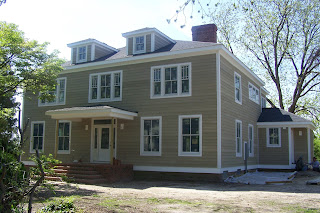After weeks of research and watching on-line videos of airless paint sprayers, we decided to take the plunge and invest in a Graco Magnum LTS airless paint sprayer to try to knock out the interior painting in a more economical way than hiring it out to subs. Here's our gleaming brand new unit - we started the weekend with high hopes and a healthy amount of skepticism. Both were justified. Although YouTube videos illustrate how a room can be fully painted in 6 minutes, we knew that wasn't going to happen. But, we secretly harbored small slivers of hope that this little box could contain a game-changer for our painting needs.

Two hours in and we were over it - the learning curve is STEEP. Despite the repeated five star reviews testifying that using this sprayer is so easy a monkey could do it - just pop in the DVD and follow the simple steps to paint your house with ease - we did not find that to be the case. We were both crabby beyond belief. I finally dared to boldly state out loud what we were both thinking - this was no game-changer. Rob immediately agreed. Bad investment all the way around. Using the sprayer is an art form and difficult to master in a few practice strokes. Retraction portion of this post: despite my earlier assertion that I am the better wall painter, Rob is the better paint sprayer...by far. It didn't take long for our shiny new sprayer to be covered in paint.

After I clumsily primed the master bedroom, bath and sitting room, Rob decided to give it a whirl. At that point, we also realized we had VASTLY underestimated the amount of primer we'd need - that sprayer is a hungry little monster. So, while Rob took his turn trying to tame the sprayer, I made a paint run for an additional 20 gallons of primer. Disheartened and discouraged on the paint run, I was doing budget calculations in my head to see if we could squeeze the cost of interior painting onto the project. However, to my HUGE surprise, by the time I returned, Rob had finished most of the upstairs - all walls and ceilings were primed. He excitedly exclaimed that it WAS a game-changer after all. Here's a few shots of Rob in action:


The white film on the above pictures is actually all the paint particles flying around...did I mention that this is one messy job? Safety first, as always, we both wore heavy duty paint masks the entire time, but I was skeptical that they would really be needed. They are - it's like walking in a chemical snowstorm and the air quality is about the poorest that I've ever experienced.
Sunday (Happy Mother's Day!) brought a second full day of painting, sort of. The machine is touchy and requires constant trouble-shooting, disassembling, unclogging of filters, reconnection of hoses, and on and on. We both probably could quote the trouble-shooting pages of the manual by heart we had to refer to them so many times. When the machine is working well, Rob could knock out an entire room in 15 minutes - the rest of the time is spent refilling the paint and fixing the constant issues. I kept busy staying one room ahead of Rob, cleaning up the drywall dust, prepping and clearing the room, and in some cases, covering the floors. Bottom line, despite the issues, we were able to get the entire house primed and some of the finish coats on the ceilings in a weekend - that would not have been possible with the two of us using rollers and brushes. And, it saves on the arms, neck and ladder climbing, but adds to the stress and frustration level.
A few shots of the fully primed interior:
Did I mention that clean-up also requires some time? Not only the machine, but also the people - here's Rob with a nice coating of primer (paint your bald spot?).
Next up, the finish paint on the walls. We have now invested in the pressure roller attachment for the Graco sprayer for the walls. Hmmm...doubling our investment or throwing good money after bad? Here's a few of our sample "paint swatches" on the walls as we attempted to line up our color palette:
So, the three painters on this project are not me, myself and I, but rather, Rob, me, and the MAGNUM. If this post has not dissuaded you from trying an airless sprayer, here's a few tips based on our weekend of experience, knowledge accumulated the hard way:
1. Clear the room entirely - a completely empty room produces the best results
2. Invest in and wear good quality painting masks
3. Wear only clothes you don't care about or cover up in the dreaded Tyvek suit
4. Give yourself plenty of time to master the art of spraying. Practice in a less visible room or area.
5. Learn the machine, filters, hoses and parts completely before getting started.
6. Bookmark the trouble-shooting pages in the manual before you get started. You will need them - the only question is how quickly..
7. Cover, seal and protect all surfaces that you don't want painted - even if they are completely different floors of the house. Paint particles have some serious traveling power.
8. Be prepared for issues, high stress, and don't try this with a deadline.
ENJOY!



























































